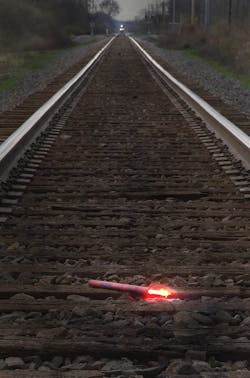Firefighter Safety: Don't Play with Trains
It seems like every week we read about an emergency responder being hit by a vehicle while working an incident scene on a highway. And, with each incident, we seek to ratchet up responders' awareness of operating in dangerous environments; making sure that apparatus is positioned to block the areas of roadways where we are working and mandating that each responder is wearing high visibility clothing and keeping an eye on oncoming traffic.
While traffic incidents, because we respond to them quite often, are uppermost in our safety consciousness, we need to remember that there are other transportation hazards out there that we need to be aware of as well.
Did you know that, according to Operation Lifesaver, approximately every three hours, someone is struck by a train in this country? And, that a motorist is 40 times more likely to die in a crash involving a train than in a collision with another motor vehicle.
Railroading can be a violent business. Freight cars coupling sound like minor explosions, accelerating diesel engines reverberate like distant thunder, and when trains tangle with a vehicle or human being, well, they always win.
Railroaders live by safety rules-if they violate them, they get fired--if they are lucky. If not, they can be seriously injured or die.
If you have rail lines running through your response district, it might be time to review some tips on how to keep your personnel from becoming a statistic.
One of the first things railroads teach a new hire is: "Expect a train movement on any track in any direction at any time." If your response district contains high train frequency main lines, you probably already know that freight trains do not run on any set schedules. On branch lines that are infrequently used, there is the added danger of trains running in "dark territory," that is they are not under the direct control of a dispatcher.
Responding to an incident on or near rail tracks, the first thing you want to do after sizing up the situation is to stop all train traffic if your personnel will be operating in railroad property.
Keep in mind that trains cannot stop quickly. An average freight train traveling at 55 miles per hour requires over one mile to come to a complete stop.
Most railroad trackage in the U.S. is under the direct control of a dispatcher. Having your fire or police dispatcher contact the railroad that operates the tracks will result in activation of red signals and radio contact with trains to insure they stop clear of danger.
The dispatcher, sitting at a computer screen, will then begin to stop or slow more distant trains to prevent further collisions. Keep in mind that having the dispatcher stop trains on a busy main line most likely will result in slow or stop orders reaching quite long distances, even into other states.
The only problem is that you need to make sure that the railroad your dispatcher is contacting is the one running on the tracks where you are working. There may be multiple lines side by side operated by different railroads or there can be local switching operations and short line operators that run on tracks that are not directly controlled by a dispatcher.
These railroads may operate by track warrants that give them permission to run trains between two points at certain times.
It may be that the only time their dispatcher is aware of their movements is when they are switching cars into a main line for pick up by a larger railroad.
If you know the contact numbers of these short and switching lines, and can get through to a responsible person, they can usually contact the crews by radio and inform them of the situation.
If not, you have an alternative.
The Federal Railroad Administration requires all railroads operate by a set of rules. In most small and medium size operations, it is the General Code of Operating Rules. Larger railroads have their own set of rules but in general, they too follow the GCOR guidelines.
One of the rules, 5.6 to be exact, requires all trains to come to a complete stop if they encounter a lit fusee burning on or near its track. They can move after the fusee burns out or after 10 minutes, but must move at restricted speed until its head end is one mile beyond the fusee. The fusee should be inside the rails of the line you want to stop-the rule does not apply if a fusee is inside the rails of an adjoining track.
If you must operate on or near railroad property, take the precaution of setting out fusees on each end of the operation, preferably a mile or so from your location. When police want to help out, this is a good job for them.
The CSX railroad has an excellent program for first responders at www.csxsafe.com. Log on, take the course, learn something about railroad safety, take the exam, and if you pass, print out their nifty certificate suitable for framing (and CE units).
As I've always told my son, if you mess with trains, you never win.
